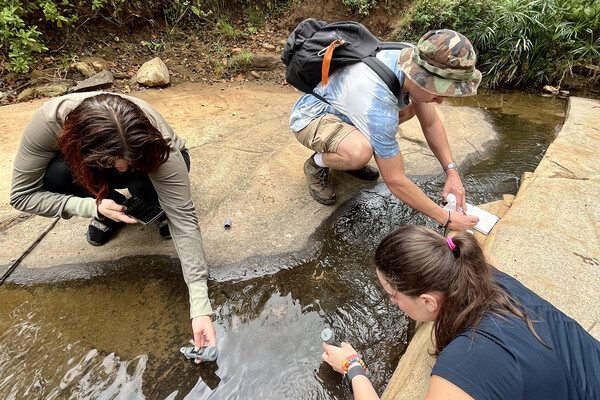
Griffin Pitt, right, works with two other student researchers to test the conductivity, total dissolved solids, salinity, and temperature of water below a sand dam in Kenya.
(Image: Courtesy of Griffin Pitt)
Hundreds of thousands of people have been descending on Philadelphia throughout the past week, drawn by the allure of plants. The Philadelphia Flower Show is approaching two centuries of celebrating all things horticultural, and beyond the creative displays of blooms from around the world, it features extensive judging, with experts examining each inch of these plants for their health, beauty, size, and myriad other traits.
Eleni Katifori, an assistant professor in the Department of Physics and Astronomy in the School of Arts & Sciences (SAS), looks at plants in a different way. When she inspects a leaf, she sees deep mathematical theories about network structure, geometry, and topology.
Katifori is one of the first faculty members hired through SAS’s Evolution Cluster, an interdisciplinary network of researchers that approach the core concepts of biology from various scientific perspectives.
Together with colleagues from Germany’s Max Planck Institute for Dynamics and Self-Organization and the New York Botanical Garden, Katifori recently published a study that outlines how the smallest systems of veins in plant leaves reveal traits about the network’s overall characteristics.
The organization of these veins can therefore serve as a “fingerprint” for the leaf, with small details revealing bigger-picture information about the plant.
“We’re trying to extract as much information as possible from the smallest veins on the leaf,” Katifori says. “Other researchers have tended to zoom out and study the biggest, most prominent aspects of the vasculature, but a lot of the action is really happening on the smallest level, since they carry so much of the flow. We’re trying to make mathematical tools that provide a good description of the overall phenotype of the leaf based on what these things are doing and how they’re organized.”
Understanding the fundamentals of those networks would give biologists new tools to work with when they study plants. For example, analyzing the finer veins in a small fragment of a leaf could help identify the plant it came from, and comparing how those circulatory networks differ in plants exposed to different environmental factors could lead to insights about their adaptations to climate change.
“We hope this work will prove very useful for plant biologists, botanists and people who try to understand plants’ relationship with climate and the environment in general,” says Katifori. “Were trying to incorporate math that hasn’t been used in those fields before.”
Because these theories are rooted in deeper mathematics, plants are only the beginning.
“If we develop these tools further, we might eventually be able to apply them to the human vascular system,” Katifori says. “Modifications in the the higher-order capillaries in the brain or other organs might be relevant for predicting health problems, for example.”
Evan Lerner

Griffin Pitt, right, works with two other student researchers to test the conductivity, total dissolved solids, salinity, and temperature of water below a sand dam in Kenya.
(Image: Courtesy of Griffin Pitt)

Image: Andriy Onufriyenko via Getty Images

nocred

Provost John L. Jackson Jr.
nocred